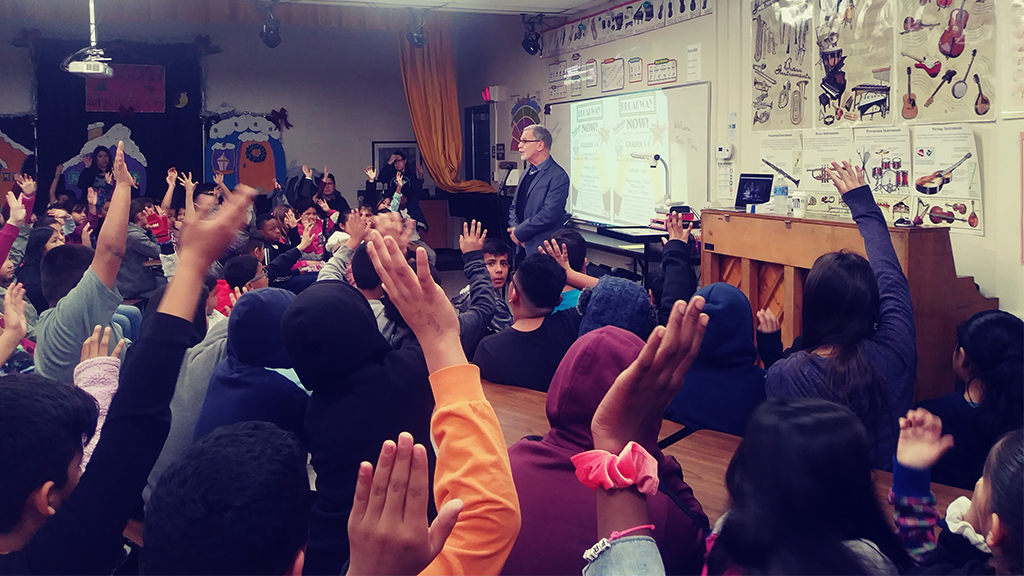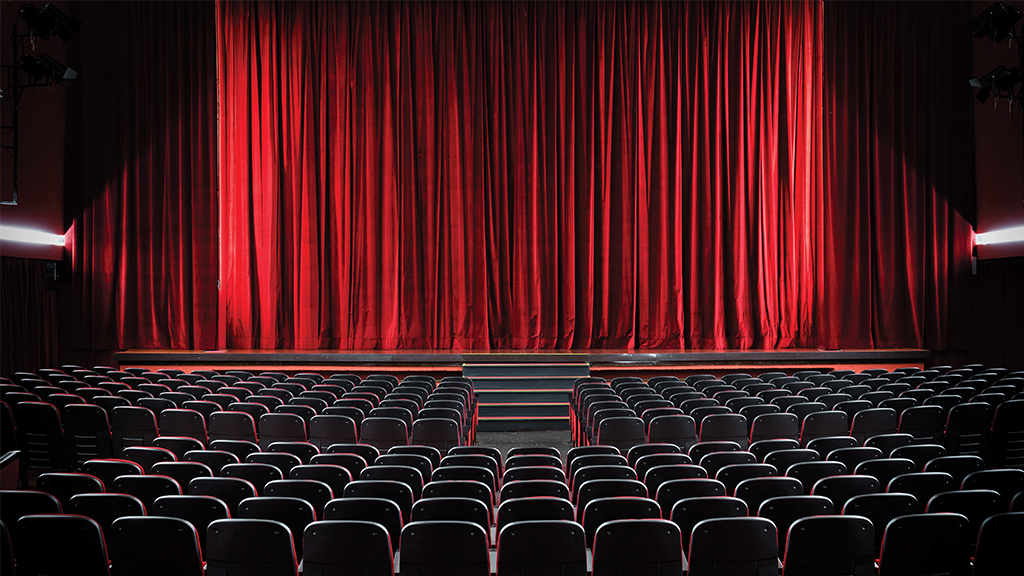
Photo credit: Catie Sadlier, Salinas Elementary, San Bernardino, California
Education has allowed me to identify with characters from different backgrounds and feel comfortable navigating across income, educational, and class differences. It’s very clear to me that my education has been the key to competing effectively and being able to play characters that come from different cultures and places and stations in society.
A college cadet in “An Officer and a Gentleman,” a crazy Mexican bandit in “Three Amigos!,” a widowed father of a boxing family in “Resurrection Blvd.,” the Secretary of State in the “West Wing,” a chef in Queens who’s Ugly Betty’s father, an FBI agent pursuing “The Punisher,” a lawyer for the drug cartel in “Mayans MC,” and Rita Moreno’s dancing husband in “One Day at a Time.”
How does that happen to an 8-year-old boy from a Spanish-speaking country only 90 miles away but a thousand miles away culturally? I look back at my decades of success in one of the most challenging professions on the planet with amazement. Only 2 percent of the actors union make a living income, and only 5 percent of characters on television are Latino.
When you consider my beginnings as a poor, immigrant, English Learner entering a radically different culture with little or no family resources, the career that followed seems miraculous.
We landed in Miami, Florida, on Dec. 8, 1960, my mother’s birthday, in the middle of the Cold War. We had to depend on the generosity of the U.S. government and Catholic Charities for food, clothing, and shelter to survive. We shared a two-bedroom house with another family, five of us and eight of them.
The adverse impact of being ripped out of your familiar culture and thrust unexpectedly into a new language and a massive, complex country is a trauma that defines you.
It was a seismic shock to be extricated from everything familiar: a common language, common food, common music, common religion. And to see my parents struggle in a strange world, leaving promising careers for limited opportunities. My father, in particular, battled alcoholism and cigarette addiction for most of his life.
Confronting poverty, marginalization, and family dysfunction are challenges that can either make you or break you. They almost broke me.
From elementary through high school, I had great difficulty identifying, expressing, or managing my emotions. Pressures at home caused me to internalize my feelings, which would convert into depression, anxiety, or anger. That’s why I play angry characters so well. Easily accessible. Even though I seemed to be functioning OK externally, internally I felt withdrawn as if it was all happening through a fog.
Then a teacher in high school changed everything. He introduced me to the performing arts. He taught history. After listening to me read aloud in class from the Declaration of Independence, he signed me up for speech team competitions where, to my surprise, I succeeded, often advancing to state, regional, and national finals. He then encouraged me to try out for theater productions, where I landed major roles in dramas and musicals. It’s where a gradual transformation began.
These activities engaged me in ways that were new and different. They somehow freed me, made it easier to deal with my life internally and externally. I learned how to work introspectively, process things, and function productively in a group. The fog started to clear, and I began to understand myself and others better.
Identifying and controlling my emotions became easier, and I felt more confident and communicated better with others. I was aware of surging new skills that made it easier to manage my life, at school and at home.
These social and emotional skills evolved from the disciplines required for performance. Attending rehearsals, meeting short-term objectives, and working towards a specific goal required persistence and resilience. I was engaged intellectually, emotionally, socially, and creatively. My academic and social life improved. My participation in student activities increased, including student government.
The performing arts were instrumental in helping me manage language and cultural barriers, overcome deep insecurities and stigmas due to alcoholism and dysfunction in my family, and face the difficulties of being a stranger in a strange land.
I am a living example of how the arts play an essential role in educating the whole child. The arts must be at the forefront of our conversations when we are re-examining core best practices and curriculum design.
Research collected by ArtsEdSearch reveals how the arts are key to bridging the achievement gap in school. Studies assert that the arts bolster the skills demanded of a 21st-century workforce and enrich the lives of young people and their communities. They prepare students for success in school, work, and life by boosting math and literacy achievement, strengthening perseverance, and facilitating cross-cultural understanding.
I know this is true because I lived it. These developing abilities to relate to others and perform well in school gave me the confidence to navigate back and forth in my bilingual world and form satisfying friendships. I was able to feel equally comfortable with my Anglo or Latino friends and with their friends and families. It expanded my sense of identity through stronger ties to my family and my cultural community in Spanish and my Anglo world in English.

Photo credit: PHOTOLOGY1971/STOCK.ADOBE.COM
A 2012 report from the National Endowment for the Arts showed that, by nearly every indicator, a student from a lower socioeconomic status (SES) background with a high-arts educational experience significantly outperformed peers from a low-arts, low-SES background, closing (and in some cases eliminating) the gap that often appears between low-SES students and their more advantaged peers.
Research also confirms that the arts don’t just impact standardized test scores.
According to the Arts in Education Partnership’s report entitled “Preparing Students for the Next America: The Benefits of an Arts Education,” creativity is among the top ranking of “in demand” qualities, as are the skills of communication and collaboration.
Why? Because in the future, computers will handle most of the hard skill work, but human beings will provide creativity. However, the study showed that 85 percent of employers seeking creative candidates had trouble finding qualified applicants.
If this research is true, why aren’t more school districts integrating the arts comprehensively into the educational experience? Could it be that too many decision-makers don’t trust the arts pedagogically because they’re not acquainted with the arts enough to know what they can do, how they can help?
Could it be possible that we need to consider more of a right-brain, left-brain balance in our curriculums and significantly consider the social and emotional well-being of our students?
This has been proven repeatedly as an essential factor in diminishing the dropout rate and affecting academic performance. The single factor most responsible for dropping out of school is the lack of emotional connection to the school, a relationship to a teacher, or a connection to an engaging experience. Are we putting the cart before the horse and addressing our post-pandemic challenges with an overwrought preoccupation with accelerated learning before considering the social and emotional needs of the whole child as an essential part of our educational strategy?
I realize I am not an education or trauma expert. But having experienced significant trauma myself and having worked for many years with students from poor areas, I feel confident I can at least serve as a relevant witness as to who they are and what I feel they most need, particularly in our current situation.
COVID-19 has widened racial disparities. It’s been devastating for children of color. Just one in five Black and one in six Latino wage earners were able to work from home. Most parents of color were unable to provide direct, daily support to their school-age children. Also, these children have been disproportionately affected by the pandemic’s social-emotional toll, such as higher community death rates and increased food insecurity.
Many of us are already highly aware of these realities and the ensuing challenges. What can we do about them?
Nancy Rappaport is a professor of psychiatry at Harvard Medical School. Her book, The Behavior Code, boils down the obstacles to learning experienced by children suffering from chronic trauma:
- Trouble forming relationships
- Poor self-regulation
- Negative thinking
- Hypervigilance
- Executive function challenges.
The creative dramatics process can begin to grapple with all these symptoms. Culturally responsive process drama, when delivered effectively, can be an efficient, skillful way of dealing with this syndrome.
Traumatized children often have trouble managing strong emotions. Acknowledging and naming these emotions helps children move towards expressing them in a more appropriate way. The ability to self-narrate—to mentally talk themselves through what they need to do as they carry out a task is referred to in the theatrical process as an inner monologue or interior narrative. The children dance, sing, act, improvise, connecting to their big feelings and processing them.
Rappaport writes, “If they can connect with what they’re feeling, they will settle.” They will experience a release of the feeling through a large, expansive expression of it both individually and in the group, and it will have less of an effect on their overall behavior the next time it surfaces. They will know how to manage it better.
A supportive, creative process allows them to do things their own way without judgment. There are no wrong decisions creatively, only the best we can do at the moment. The rehearsal is a continuing process of trying your best to make it better without internal or external judgment.
Gradually, they begin to trust the guidance of the teaching artists and to identify their emotions and express them physically, vocally, and emotionally through performance. Incrementally, they change destructive patterns.
Finally, chronic trauma affects children’s memory, their ability to pay attention, plan, think things through. The theatrical process focuses attention on the immediate task at hand, with short-term objectives and long-term goals serving as an exercise in organizing, planning, and completing tasks that then transfer to similar academic and personal responsibilities. This allows these children to begin to manage one of their deepest fears: the unpredictability of their future.
I am not suggesting that performing arts in schools is the panacea to all our problems. But I do believe that they can be a highly effective form of creative group therapy fostering healing and recovery for these compromised children.
For many of the neediest children, school is the first place where they can cry for help, where they can first hope for relief. And I believe teachers are right to demand the addition of nurses, sociologists, and psychologists at school sites for a coordinated assistance approach.
I ask you to consider the performing arts as an essential tool and a dynamic approach to addressing our current crisis and ensuring positive outcomes and recovery. We need to approach learning through social and emotional recovery first; recovery engenders learning.
We must use the performing arts to provide an educational balance by igniting right-brain creativity as well as critical thinking and problem-solving skills essential for today’s crises. It is imperative that we establish the necessary experiences for processing and healing trauma through creative expression and personal voice.
Actor Tony Plana is the founder of Arts in Play, an after-school program that applies theater techniques to engage children. This article is adapted from his presentation at NSBA’s annual conference in April.

Share this content